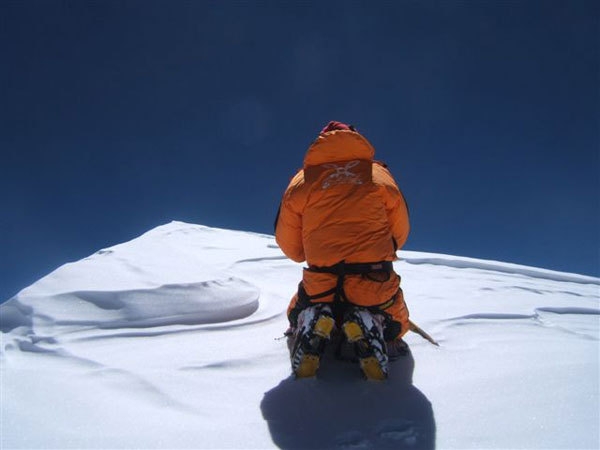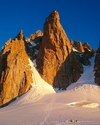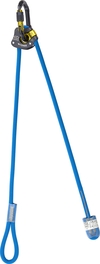A question of style: Meroi, Pasaban, Kaltenbrunner and all the 14 8000m peaks
Edurne Pasaban with Kanchenjunga and Gerlinde Kaltenbrunner with Lhotse have reached the summit of 12 8000m peaks. Nives Meroi and Romano Benet on the other hand have had to abandon their Kanchenjunga summit bid and have therefore climbed 11. The thoughts of Manuel Lugli about this female "race" to complete the tour of the 14 highest mountains in the world.

 1 / 4
1 / 4
Nives Meroi on the summit of K2
 arch. Meroi
arch. Meroi
I followed their every move on Kangchenjunga as always, as always since 1998, since Nanga Parbat. I.e. since when I began to co-ordinate the expedition logistics of Nives Meroi and Romano Benet. Sometimes I travelled with them. First in 1994, to K2 from the North, when it all began, even our friendship and then, in 1996, to Everest from the North. Other times I followed their progress from Base Camp of some 8000m peak, such as Lhotse and Dhaulagiri to make sure that everything ran smoothly. This was no straightforward, easy task, because this simply isn't their style. Because when you don't use high altitude sherpa nor supplementary oxygen; when you carry your camps on your back, moving them up as you climb and transporting them back down, one after the other including all waste; when you choose the hardest routes or new lines instead of going for the easier option up the normal routes; when you climb K2 and you know that there's no one else, and I mean no one else on the mountain; when you carry your companion back down with a broken leg, with the Makalu winter winds bowling you over; when you choose the mountains you like most, in that precise moment, without thinking too much whether it's the right choice for your overall project. When you act, when you live things in this manner, then nothing comes easy.
Once again I followed them, from here, with the usual attention and apprehension. Not so much for their safety, even if their goals certainly weren't without risks. My apprehension was "technical", connected to times, logistics, the possibility of things becoming too complicated as in the end they turned out to be. I feared certain aspects of their way of taking to the mountains, of their characters, certain humane difficulties in playing the waiting game. Not so much due to the anxiousness of a competition or challenge in this inevitable game of 14 eightthousanders, as they don't suffer from this form of anxiety. Rather, their desire to be at a mountain and climb it, which is infact an anxiety which many mountaineers I've met share, even the most expert among them.
Certainly the switch of objectives from Kanchenjunga to Annapurna South and then back again, seeing the tremendous difficulty in climbing the immense vertical desert of the Annapurna South Face practically on their own, did not help their undertaking. On the contrary, I believe that a large part of their "failure" on Kanch can be put down to this.
But when I learnt about Nives' decision to abandon the summit - from the information we have to go by she was on excellent form - I understood that perhaps the two had reached, paradoxically, their purest success as a cohering couple. Cohaerere, the Latin verb from which the participle "coher" derives, means "become united, to hold together." If one of them stops and the other continues, then there is no cohesion, the single mass breaks and there is only one way out: descend together. I think that Romano felt, for the first time ever in his life as mountaineer and man, the burdon of abandoning a summit and the sensation of feeling frightened together. Fear of not being able to pull it off: not only of reaching the summit, but of descending. And Nives did the only thing she could do with her, with their, background: she descended with Romano. Renouncing a summit which was within her grasp. Argentine mountaineers would describe this as a "fracàso", and who knows how loud the avalanche of abandonment was, while Edurne Pasabàn ascended to the summit with her companions and sherpa.
The exact opposites of an undertaking, success and failure, can often be less distant if examined at close range. Nives was in fine health and could ascend, at least apparently without major problems, but descended with her climbing and life companion. Alone once again, shouldering all their gear from their "mobile" camps - sixteen, seventeen kilos carried up and down on their own. This is only normal, you might say. It would be interesting to find out what is normal and what isn't in the clouds at altitude. Edurne climbed with her companions from Camp 4 and reached the summit, deservedly, without a shadow of doubt. Then she too began the descent, with extreme difficulty and suffering she descended to Camp 3 in eight hours, when other companions reached her with sherpa and supplementary oxygen to guarantee her return to Base Camp. Just like after her ascent of K2, which otherwise wouldn't have happened. All you need to do is watch the videos of her arrival at Base Camp to realise how much the altitude drained her physically and psychologically. And it is here that, without wanting to, the distance between success and the fracaso shorten. I believe it is here that the competition, which nevertheless exists, untwines and looses any sense, albeit if it ever had any. Because some things surely must count, must be important. Otherwise everything goes and everything is the same.
Romano Benet and Luca Vuerich transported Nives down Makalu in winter, with a broken tibia and fibula practically from advanced base camp to base camp, without any external help except for the support of the cook who went ahead to prepare the camp for their arrival. No rescue operation from Italy, with helicopters and Mountain Guides. The only help they received from Italy were my telephone calls to tell them that perhaps a helicopter would have reached Base Camp in a couple of days, weather conditions permitting. In the end Nives flew to Kathmandu, while Romano and Luca spent a week walking out with all the gear. No heroism: simply this is how things work in the Himalaya. Or should work.
We learnt that Gerline Kaltenbrunner summited Lhotse on 20 May, her 12th eightthousander without supplementary oxygen. The Austrian is exceptional and extremely strong, we've known this for ages. But in her case, too, there is a small, big difference: her husband, Ralf Djumovits, mountain guide, a great and meticulous organiser of commercial expeditions who, with the help of sherpa, prepares with Teutonic skill and care every camp for his wife's ascent. Perhaps here therefore the difference in style is no longer so subtle.
Yes, damn it, otherwise everything goes. Otherwise every ascent up every normal route, already prepared, is an undertaking. That climbing with or without sherpa, with or without supplementary oxygen all comes down to the same thing. That climbing at altitude in alpine style has the same technical value as an ascent planned by a big team. This line of thought continues all the way to the idea the "good" Himalayan climbing must have equal rules for all, that need to be channelled, that perhaps climbers should be selected on the basis of attitude tests - who and with what title? - and that one must organise a Himalayan mountain rescue service, meaning that almost certainly the number of amateurs will double as they feel safe in the knowledge that rescue teams will get them should there ever be the need.
However things may be, Nives and Romano have, as always, paid for and been shaken by their style. The official balance sheet seems to be in the red and who knows how much they will be criticised for their way of acting beyond given methods and certain expectations. I'm sure they're not particularly happy about how things went, but if I know them well enough, then I think they'll respond to their critics as did Bertolt Brecht: "Seeing that the seats of reason were occupied, we sat on those of unreason”. Amen.
Manuel Lugli
Once again I followed them, from here, with the usual attention and apprehension. Not so much for their safety, even if their goals certainly weren't without risks. My apprehension was "technical", connected to times, logistics, the possibility of things becoming too complicated as in the end they turned out to be. I feared certain aspects of their way of taking to the mountains, of their characters, certain humane difficulties in playing the waiting game. Not so much due to the anxiousness of a competition or challenge in this inevitable game of 14 eightthousanders, as they don't suffer from this form of anxiety. Rather, their desire to be at a mountain and climb it, which is infact an anxiety which many mountaineers I've met share, even the most expert among them.
Certainly the switch of objectives from Kanchenjunga to Annapurna South and then back again, seeing the tremendous difficulty in climbing the immense vertical desert of the Annapurna South Face practically on their own, did not help their undertaking. On the contrary, I believe that a large part of their "failure" on Kanch can be put down to this.
But when I learnt about Nives' decision to abandon the summit - from the information we have to go by she was on excellent form - I understood that perhaps the two had reached, paradoxically, their purest success as a cohering couple. Cohaerere, the Latin verb from which the participle "coher" derives, means "become united, to hold together." If one of them stops and the other continues, then there is no cohesion, the single mass breaks and there is only one way out: descend together. I think that Romano felt, for the first time ever in his life as mountaineer and man, the burdon of abandoning a summit and the sensation of feeling frightened together. Fear of not being able to pull it off: not only of reaching the summit, but of descending. And Nives did the only thing she could do with her, with their, background: she descended with Romano. Renouncing a summit which was within her grasp. Argentine mountaineers would describe this as a "fracàso", and who knows how loud the avalanche of abandonment was, while Edurne Pasabàn ascended to the summit with her companions and sherpa.
The exact opposites of an undertaking, success and failure, can often be less distant if examined at close range. Nives was in fine health and could ascend, at least apparently without major problems, but descended with her climbing and life companion. Alone once again, shouldering all their gear from their "mobile" camps - sixteen, seventeen kilos carried up and down on their own. This is only normal, you might say. It would be interesting to find out what is normal and what isn't in the clouds at altitude. Edurne climbed with her companions from Camp 4 and reached the summit, deservedly, without a shadow of doubt. Then she too began the descent, with extreme difficulty and suffering she descended to Camp 3 in eight hours, when other companions reached her with sherpa and supplementary oxygen to guarantee her return to Base Camp. Just like after her ascent of K2, which otherwise wouldn't have happened. All you need to do is watch the videos of her arrival at Base Camp to realise how much the altitude drained her physically and psychologically. And it is here that, without wanting to, the distance between success and the fracaso shorten. I believe it is here that the competition, which nevertheless exists, untwines and looses any sense, albeit if it ever had any. Because some things surely must count, must be important. Otherwise everything goes and everything is the same.
Romano Benet and Luca Vuerich transported Nives down Makalu in winter, with a broken tibia and fibula practically from advanced base camp to base camp, without any external help except for the support of the cook who went ahead to prepare the camp for their arrival. No rescue operation from Italy, with helicopters and Mountain Guides. The only help they received from Italy were my telephone calls to tell them that perhaps a helicopter would have reached Base Camp in a couple of days, weather conditions permitting. In the end Nives flew to Kathmandu, while Romano and Luca spent a week walking out with all the gear. No heroism: simply this is how things work in the Himalaya. Or should work.
We learnt that Gerline Kaltenbrunner summited Lhotse on 20 May, her 12th eightthousander without supplementary oxygen. The Austrian is exceptional and extremely strong, we've known this for ages. But in her case, too, there is a small, big difference: her husband, Ralf Djumovits, mountain guide, a great and meticulous organiser of commercial expeditions who, with the help of sherpa, prepares with Teutonic skill and care every camp for his wife's ascent. Perhaps here therefore the difference in style is no longer so subtle.
Yes, damn it, otherwise everything goes. Otherwise every ascent up every normal route, already prepared, is an undertaking. That climbing with or without sherpa, with or without supplementary oxygen all comes down to the same thing. That climbing at altitude in alpine style has the same technical value as an ascent planned by a big team. This line of thought continues all the way to the idea the "good" Himalayan climbing must have equal rules for all, that need to be channelled, that perhaps climbers should be selected on the basis of attitude tests - who and with what title? - and that one must organise a Himalayan mountain rescue service, meaning that almost certainly the number of amateurs will double as they feel safe in the knowledge that rescue teams will get them should there ever be the need.
However things may be, Nives and Romano have, as always, paid for and been shaken by their style. The official balance sheet seems to be in the red and who knows how much they will be criticised for their way of acting beyond given methods and certain expectations. I'm sure they're not particularly happy about how things went, but if I know them well enough, then I think they'll respond to their critics as did Bertolt Brecht: "Seeing that the seats of reason were occupied, we sat on those of unreason”. Amen.
Manuel Lugli
Note:
| Links Planetmountain | |
| News Meroi - Benet | |
| News Gerlinde Kaltenbrunner | |
| News Edurne Pasaban | |
| Links www | |
| nives.alpinizem.net | |
| gerlinde-kaltenbrunner.at | |
| edurnepasaban.com | |
| nodoinfinito.com | |
Latest news
Expo / News
Expo / Products
High quality suede gloves designed for via ferrata.
Highly breathable skyrunning t-shirt
Light and flexible hiking shoeit
Climbing shoe designed for climbers looking for comfort.
Adjustable lanyard for mountaineering and rock climbing by Climbing Technology
Lightweight quickdraw ideal for onsight climbing



 Copia link
Copia link























